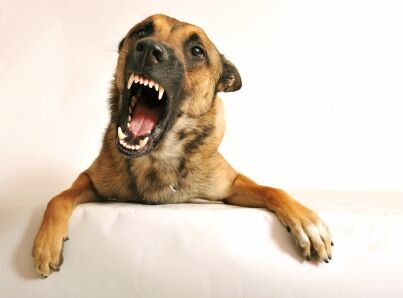
Routinely, Cleveland Dog Training Classes includes how to prevent dog aggression with appropriate dog training. Often, however, I am called on by dog owners to deal with their dogs that have problems with aggression. I prepared
this article to help dog owners and others better understand elements of dog aggression and to provide insight into dog training that includes anti aggression training.
Natural dog drives
Dog aggression comes from basically three genetic drives: pack drive, prey drive or defense drive. There are many types of aggression all of which are derived from these three drives. It’s important to know what drive or drives a dog is in when he is being aggressive because aggression from each drive or a combination should be treated differently.
In pack drive, dogs instinctively attach to a group and may only be there to reproduce. When dogs are in their prey drive they desire to hunt and eat. In their defense drive, dogs attempt to protect themselves, members of the pack or their ‘things’.
To switch dogs out of their prey drive, I distract them through their defense drive. To get dogs out of their defense drive, I distract them through their prey drive. To switch them to a more inferior position in the dog’s pack drive, I work with dog owners to establish leadership (not domination) in such a way that dogs feel they can predict the consequences of their behaviors and, if they follow their “leader,” only good things will come of it. If two or three drives are involved, I always start with leadership and put the dog’s prey drive on command.
I’ve categorized the drives into sub-categories of aggressive behaviors. Some of the kinds of aggression that fall into the pack drive are: dominance, possessiveness, territoriality, protection, intra-species, competiveness and learned behaviors.
The kinds of aggression that fall under the prey drive are: play, reflexive, predatory, frustration and competitiveness.
The defense drive category includes fear, defending prey or pack, maternal protection, and a group that, I believe, comes from irritability such as physiological disorders, pain and frustration.
As you can see, some of the drives overlap. For example:
When a dog growls if you go near his food, he would be defending his prey. At the same time, it is also natural that he would share his food with his pack leader. 2) When a dog defends his home, he is in both pack drive and defense drive. 3) When people come near a mother dog with her litter of puppies, the dog can react from her defense drive, a maternal instinct to protect her puppies which are now part of her pack, or, she could react from irritability caused by physiological factors such as birthing and hormones.
- How I treat dog aggression; a brief outline
To successfully treat an aggression case. I begin by having dog owners complete lengthy and detailed questionnaires I created from which I am able to:
- assess the dog’s natural drives
- note situations in which a dog might show aggression
- classify those situations and responses into the different drives.
In my interviewing process I ask for a detailed description of each aggressive event, including a description of the bite*. I also look at the environment to see how it may contribute to the aggression. I, then analyze the data to figure out what triggers the dog’s aggression.
In order to develop a dog training treatment plan to reduce or eliminate dog aggression, I must also assess how much the family is motivated and is capable of learning how to follow the dog training treatment plan I design for them.
Serving as an expert in dog aggression cases
When I serve as a forensic expert involving dogs, I often have only the bite to start with. As a result, I have to infer from the type of bite what drive the dog was in and whether or not he acted alone. Understanding different types of bites lets me know the dog’s intention and drive. I also interview the victim and others. (For a more detailed description on my forensic services see my page on Forensics.)
Karen’s knowledge, experience, use of her five-step model (See The Arnoff Model) and 30 years of client successes is why you’ll succeed with Cleveland Dog Training Classes (formerly the Dog-Owner Connection).

